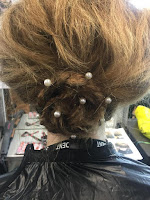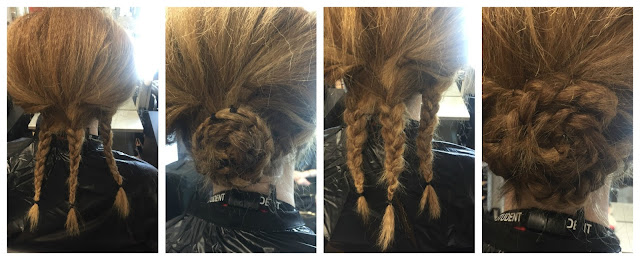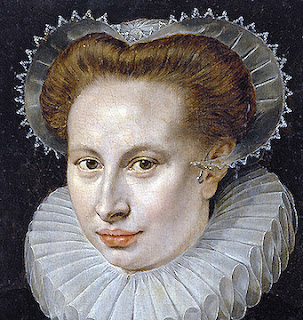Before starting this unit, I had no experience with hair styling of any sort. I am very surprised with how far I have come in one term. I wanted to include the iconic shapes from the Elizabethan era but in a contemporary style, so I had to play around with techniques and ideas. Luckily, I had a great partner who made it very easy for me to communicate my design. With Tara's design, I had to build my confidence in myself further as I was worried about completing her design in the way she wanted it. In the first practise, the height of her hair was not how we planned and the bun was not in the style Tara had described. However, after great communication with my partner and many practises I built up my skill set, became much happier the create the design (within the time) and produced a final look I was pleased with. It was a very useful task to work to my partners brief as throughout my career this will become a large aspect of my job and I enjoyed becoming a team with my partner to create the best we could.
Throughout this project, I have developed my research skills by using articles, books and websites for information and magazines and films for inspiration. I wanted to begin by researching the stereotypical styles of Queen Elizabeth and then further look into society and how other women would've styled their hair. I enjoyed comparing and combining contemporary styles I liked with historical looks and researching how modern designers do the same.
Overall, I feel this first project was very successful as it has given me the all the skills in hair styling to develop throughout my education and beyond. I have also developed my communication skills and the one thing I would change if I were to do this project again I would've practised a little bit more the get my skills perfected before the assessment so I did not panic before!
Throughout this project, I have developed my research skills by using articles, books and websites for information and magazines and films for inspiration. I wanted to begin by researching the stereotypical styles of Queen Elizabeth and then further look into society and how other women would've styled their hair. I enjoyed comparing and combining contemporary styles I liked with historical looks and researching how modern designers do the same.
Overall, I feel this first project was very successful as it has given me the all the skills in hair styling to develop throughout my education and beyond. I have also developed my communication skills and the one thing I would change if I were to do this project again I would've practised a little bit more the get my skills perfected before the assessment so I did not panic before!



















































